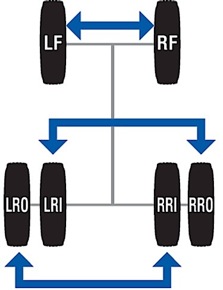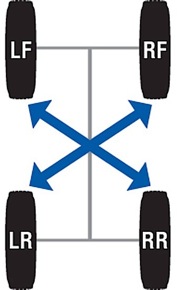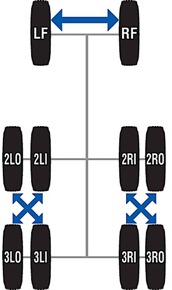to the front.
 Light Truck (4×2)
Light Truck (4×2)
If the vehicle has “all-position tires” with the same tread on all wheel positions and no retreads, and with single (instead of dual) tires on the drive axle, then the rotation pattern is simple – use the traditional X pattern.
If the vehicle has a designated “steer” tire on front and drive tires or drive tire retreads on rear – the side-to-side rotation pattern is preferred. Rotate left front to right front, left rear to right rear.
Light Truck (4×2 with duals on drive axle)
If the light truck has duals on the rear drive axle, then the fronts should be rotated side-to-side and the drives from side-to-side. However, the inside dual should be moved to the outside dual position on the opposite side of the vehicle.
Directional Tires
Directional tires are particularly designed to channel water from the center of a tire outward as the tire rotates. They have grooves in the tread that form a V-shaped pattern. This construction and tread is designed to rotate in only one direction.
These tires usually have an arrow with the word “Rotation” on the sidewall, showing the proper rotation direction. To rotate directional tires, just switch the front and rear tires on each side – right front to right rear, and left front to left rear.
 Tire Rotation on an AWD Vehicle
Tire Rotation on an AWD Vehicle
In AWD or 4×4, the X pattern is usually the preferred pattern (See diagram.)
The front right tire is moved to the left rear position, and the front left tire is moved to the right rear position and vice versa.
Rotating Notes
Before rotating the tires, a number of items should be checked. These include:
• Make sure the tires have uniform tread depths, particularly across an axle. The customer should be told that if the difference in tread depth between the front and rear tires is more than 2/32 of an inch, the tires with the deepest tread should be placed on the rear axle.
• Check to ensure the tires are inflated to the proper inflation level recommended by the vehicle manufacturer.
• Inspect to ensure the tires are the same size, same tread pattern and same brand.
• Never mix tire sizes, and never mix tire types (winter, summer, all-season).
• Never mix radial and bias ply tires on the same vehicle.
Medium Duty (6×4)
With this type of vehicle, the steer axle tires should be rotated side-to-side. The drive tires should be rotated from the second axle to the third axle in an X pattern on both sides.
The left outer tire on the second axle (2LO) will be moved to the third axle inner (3LI) position, and the 2LI tire will be moved to the 3LO position; the same pattern is repeated on the other side.
The key is to get the tires to a different axle and/or wheel position, if possible.
Full Size Spares
The X pattern recommended previously is for a four-tire rotation pattern. But what if you want to include a full-sized spare in the rotation?
It is recommended that you include it in the rotation by placing it on the rear with a tire that is closely matched in tread depth. The most worn tire should be removed and utilized as a spare. You want the four best tires – that is, the least worn – on the ground.
This is a rare rotation procedure since many vehicles feature temporary spare tires. Even with some that still feature full-size spares, owners discover they are mounted on steel wheels that do not match the aluminum alloy wheels on the vehicle.
An even newer dilemma is smaller sized full-size spares. You may have a vehicle that takes 16-inch wheels and find out the full-size spare is on a 15-inch wheel. These so-called “full-size spares” are intended for temporary use and are usually mounted on generic steel wheels.
Integrating the full-size spare in a five-wheel rotation can be done a couple of ways. A forward cross as used on FWD vehicles drops the passenger-side front tire as the new spare; the old spare would move to the passenger-side rear position and then the two rear tires would crisscross forward.
The rearward cross rotation for 4WD, RWD and AWD drops the driver’s side front tire as the new spare. The old spare still moves to the passenger rear position and then the passenger front tire moves to the driver’s side rear. The rear tires would move straight forward to the front axle position.
Many technicians inquire about replacing just one or two tires on an AWD vehicle with the remaining tires. It is highly recommended to replace them two at a time and always put them on the rear axle.
The Bottom Line
Tire rotation is an essential part of tire maintenance on all vehicles, and therefore is a key component of your customer service arsenal. It is even more important on AWD vehicles because the full-time, all-wheel drive system wears tires faster than other vehicle types.
For this reason, it is important that tires on an AWD vehicle are of the same size/diameter, tread design, brand, inflation pressure and tread depth. Varying from this regimen can cause components in the AWD driveline to be damaged and eventually fail.











